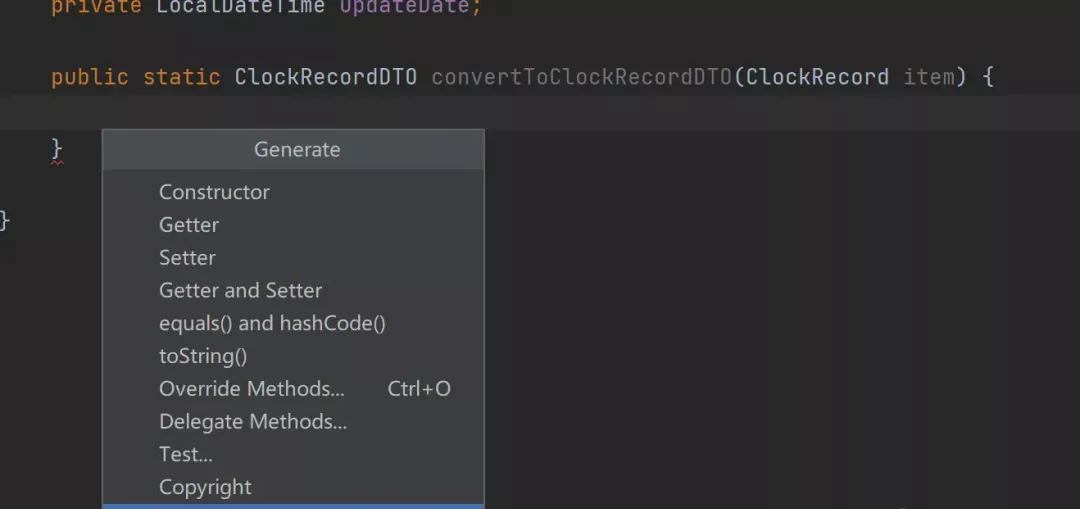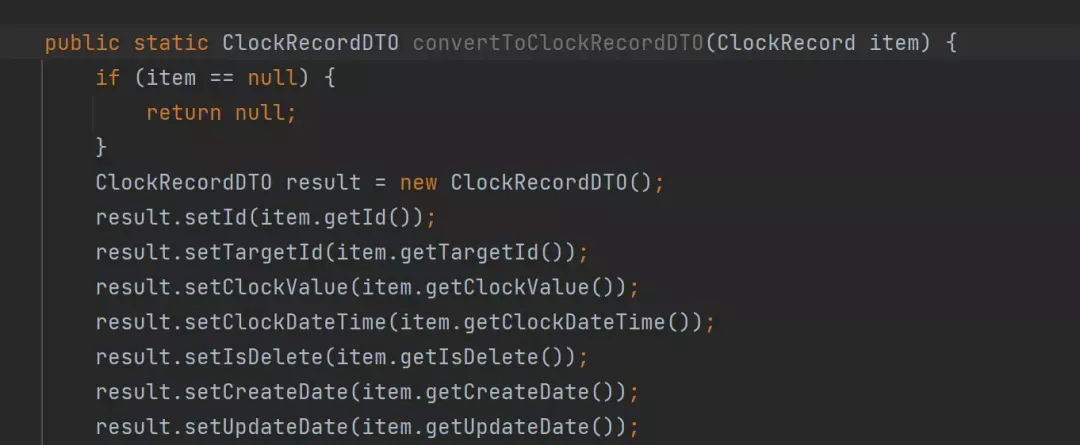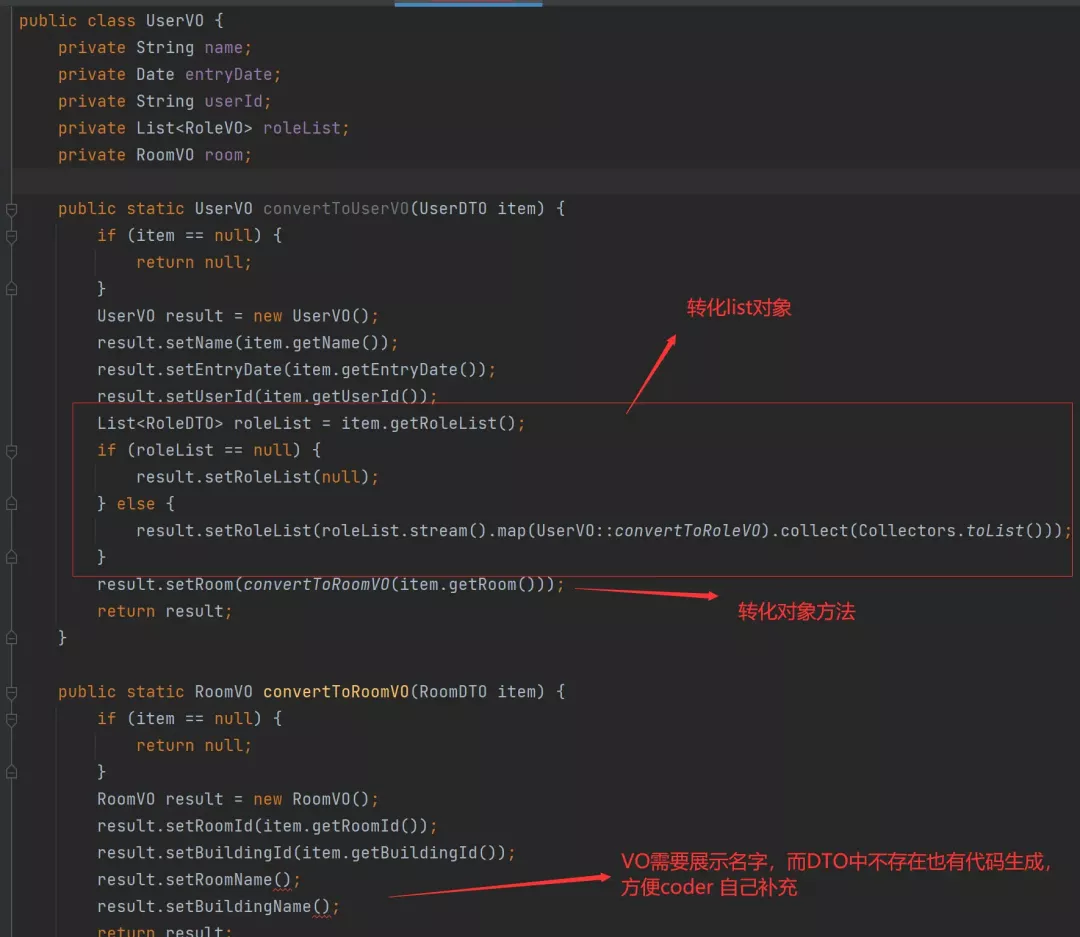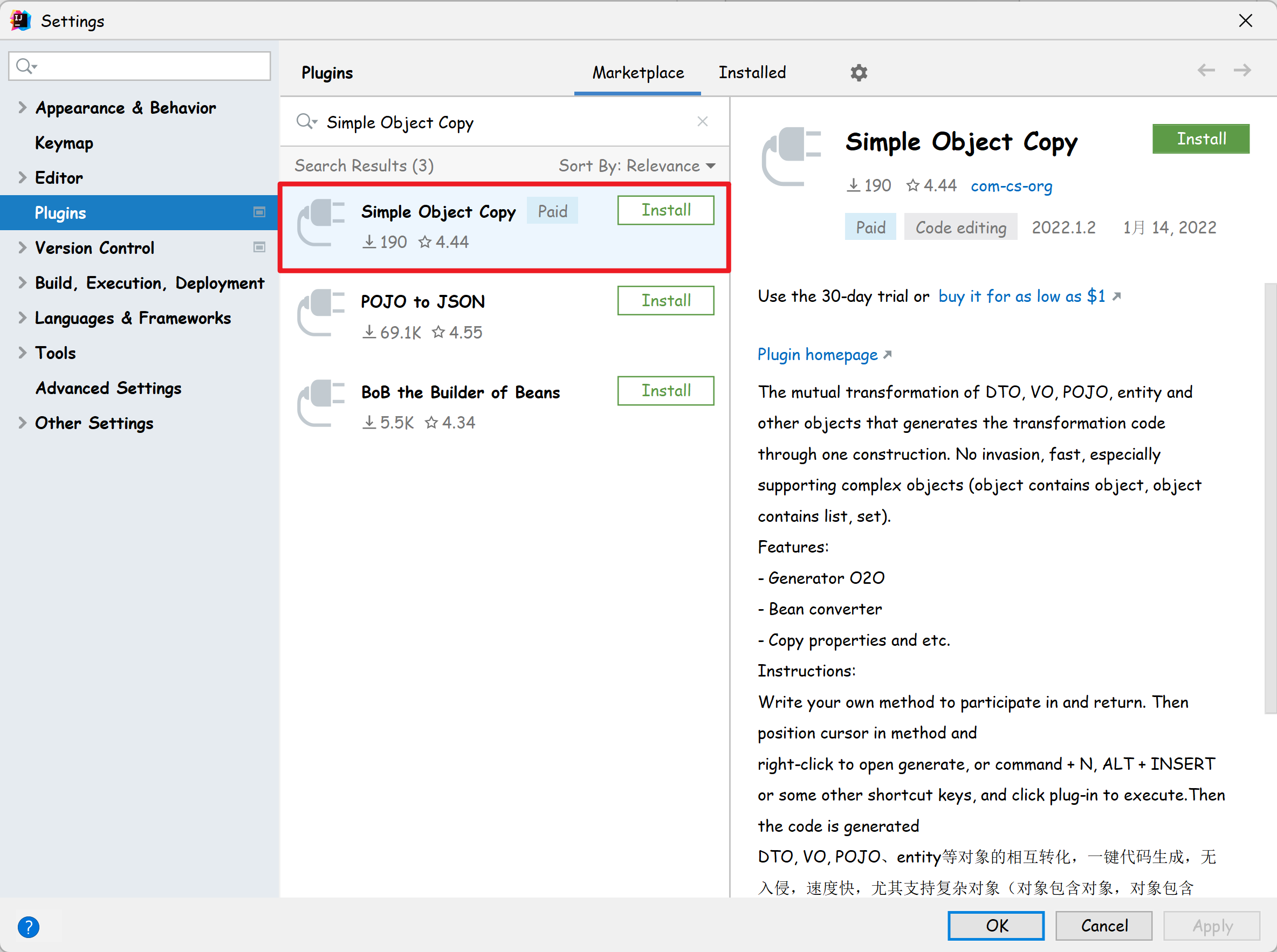1、什么是DTO、VO、BO、PO、DO、POJO
POJO的定义是无规则简单的对象,在日常的代码分层中pojo会被分为VO、BO、 PO、 DTO
VO (view object/value object)表示层对象
1、前端展示的数据,在接口数据返回给前端的时候需要转成VO
2、使用场景,接口层服务中,将DTO转成VO,返回给前台
B0(bussines object)业务层对象
1、主要在服务内部使用的业务对象
2、可以包含多个对象,可以用于对象的聚合操作
3、使用场景在服务层服务中,由DTO转成BO然后进行业务处理后,转成DTO返回到接口层
PO(persistent object)持久对象
1、出现位置为数据库数据,用来存储数据库提取的数据
2、只存储数据,不包含数据操作
3、使用场景在数据库层中,获取的数据库数据存储到PO中,然后转为DTO返回到服务层中
DTO(Data Transfer Object)数据传输对象
1、在服务间的调用中,传输的数据对象
2、DTO是可以存在于各层服务中(接口、服务、数据库等等)服务间的交互使用DTO来解耦
DO(domain object)领域实体对象
DO 现在主要有两个版本:
①阿里巴巴的开发手册中的定义,DO( Data Object)这个等同于上面的PO
②DDD(Domain-Driven Design)领域驱动设计中,DO(Domain Object)这个等同于上面的BO
2、插件如何完成转化
插件名称:Simple Object Copy
1、定义方法出入参
2、光标定位方法内,使用快捷键ALT+INSERT(WIN) 、 command + N(mac) ,或者右键鼠标选择Generate,弹出生成选项框后,选择genCopyMethod,代码就生成好了

复杂对象转化展示
代码展示:
@Datapublic class UserVO {private String name;private Date entryDate;private String userId;private List roleList;private RoomVO room;public static UserVO convertToUserVO(UserDTO item) {if (item == null) {return null;}UserVO result = new UserVO();result.setName(item.getName());result.setEntryDate(item.getEntryDate());result.setUserId(item.getUserId());List<RoleDTO> roleList = item.getRoleList();if (roleList == null) {result.setRoleList(null);} else {result.setRoleList(roleList.stream().map(UserVO::convertToRoleVO).collect(Collectors.toList());}result.setRoom(convertToRoomVO(item.getRoom()));return result;}public static RoomVO convertToRoomVO(RoomDTO item) {if (item == null) {return null;}RoomVO result = new RoomVO();result.setRoomId(item.getRoomId());result.setBuildingId(item.getBuildingId());result.setRoomName();result.setBuildingName();return result;}public static RoleVO convertToRoleVO(RoleDTO item) {if (item == null) {return null;}RoleVO result = new RoleVO();result.setRoleId(item.getRoleId());result.setRoleName(item.getRoleName());result.setCreateTime(item.getCreateTime());return result;}}@Datapublic class UserDTO {private String name;private Date entryDate;private String userId;private List roleList;private RoomDTO room;}@Datapublic class RoleVO {private String roleId;private String roleName;private LocalDateTime createTime;}@Datapublic class RoleDTO {private String roleId;private String roleName;private LocalDateTime createTime;}@Datapublic class RoomVO {private String roomId;private String buildingId;private String roomName;private String buildingName;}@Datapublic class RoomDTO {private String roomId;private String buildingId;}
3、其他转化方式
1、无入侵
市面上有很多类似的工具类,比较常用的有
- Spring BeanUtils (copyProperties)
- Cglib BeanCopier (copyProperties)
- Apache BeanUtils (copyProperties)
- Apache PropertyUtils (copyProperties)
- Dozer
- mapstruct
- JSON 序列化 再反序列化
这些工具,不仅要引入相应的依赖jar包,而且对代码有入侵,要调用对应得api方法才能进行转化,一旦遇到类型不一致,字段名稍有变动,就需要另写java代码补全字段,整体代码非常丑陋。
2、性能优势
相比上面的工具类,不是使用反射、就是是用代理、序列化操作。相比于纯正的set方法去转化,差距不是一个量级。此次不赘述。
3、灵活性、兼容性
跟上述工具类相比插件有很大优势,不再赘述,下面比较一下常用的idea插件generateO2O
| 插件 | 特点 |
|---|---|
| Simple Object Copy | 依据返回值为主,根据字段名去匹配,不会导致返回值漏属性 |
| 支持对象包含对象、对象包含list、set集合的转化 | |
| generateO2O | 以入参为主匹配字段,存在漏属性的情况 |
| 不支持子对象的转化、不支持list泛型不同的转化 |
在此推荐一个其他常用插件:generateAllSetter,搭配使用更佳
4、如何下载
打开idea plugins,切market place 搜索:Simple Object Copy
5、插件优点
1、可以节省一个个字段的设置的开发时间
2、避免了漏字段设置,ps:前端同学总是来问为啥字段总是null。
3、而且通过出入参的设计思想去开发,规范了代码,在有特殊请求转化的时候也比较方便。
:::danger
注意:该插件需要付费,6元(人民币)每年,当然学生、教育机构、公益免费。
:::

